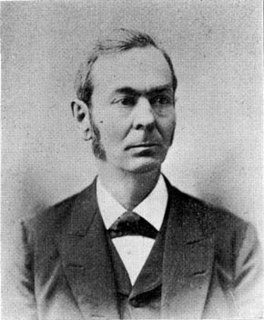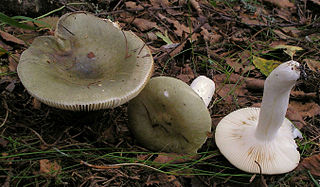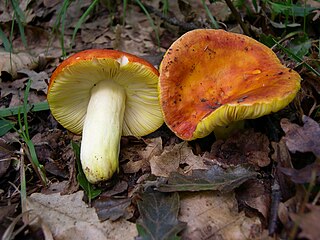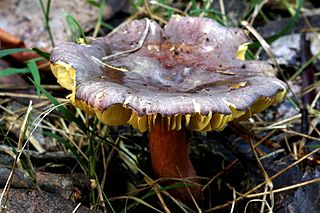
The Russulales are an order of the Agaricomycetes,. According to the Dictionary of the Fungi, the order consists of 12 families, 80 genera, and 1767 species. According to Species Fungorum, the order contains 13 families, 117 genera, and 3,060 species.

The Russulaceae are a diverse family of fungi in the order Russulales, with roughly 1,900 known species and a worldwide distribution. They comprise the brittlegills and the milk-caps, well-known mushroom-forming fungi that include some edible species. These gilled mushrooms are characterised by the brittle flesh of their fruitbodies.

Lactarius is a genus of mushroom-producing, ectomycorrhizal fungi, containing several edible species. The species of the genus, commonly known as milk-caps, are characterized by the milky fluid ("latex") they exude when cut or damaged. Like the closely related genus Russula, their flesh has a distinctive brittle consistency. It is a large genus with over 500 known species, mainly distributed in the Northern hemisphere. Recently, the genus Lactifluus has been separated from Lactarius based on molecular phylogenetic evidence.

The greater white-toothed shrew is a small insectivorous mammal found in Europe and North Africa. It is the most common of the white-toothed shrews. This species is found along the Mediterranean, Netherlands, Belgium, Ireland, Germany and Portugal; in addition, the Osorio shrew of the Canary island of Gran Canaria, originally described as a separate species, was later discovered to be a population of introduced greater white-toothed shrew. Furthermore, a subspecies of the greater white-toothed shrew, Crocidura russula ibicensis, is found on the Mediterranean island of Ibiza. In April 2008, the greater white-toothed shrew was discovered in Ireland as well. Its preferred habitats are grassland and woodland. It is slightly larger than the lesser white-toothed shrew but otherwise very similar and can often be distinguished only by close inspection of its teeth which are unpigmented.

Around 750 worldwide species of ectomycorrhizal mushrooms compose the genus Russula. They are typically common, fairly large, and brightly colored – making them one of the most recognizable genera among mycologists and mushroom collectors. Their distinguishing characteristics include usually brightly coloured caps, a white to dark yellow spore print, brittle, attached gills, an absence of latex, and absence of partial veil or volva tissue on the stem. Microscopically, the genus is characterised by the amyloid ornamented spores and flesh (trama) composed of spherocysts. Members of the related genus Lactarius have similar characteristics but emit a milky latex when their gills are broken. The genus was described by Christian Hendrik Persoon in 1796.

Russula vesca, known by the common names of bare-toothed Russula or the flirt, is a basidiomycete mushroom of the genus Russula.

Russula virescens is a basidiomycete mushroom of the genus Russula, and is commonly known as the green-cracking russula, the quilted green russula, or the green brittlegill. It can be recognized by its distinctive pale green cap that measures up to 15 cm (6 in) in diameter, the surface of which is covered with darker green angular patches. It has crowded white gills, and a firm, white stipe that is up to 8 cm (3 in) tall and 4 cm (1.6 in) thick. Considered to be one of the best edible mushrooms of the genus Russula, it is especially popular in Spain and China. With a taste that is described variously as mild, nutty, fruity, or sweet, it is cooked by grilling, frying, sautéeing, or eaten raw. Mushrooms are rich in carbohydrates and proteins, with a low fat content.

Charles Horton Peck was an American mycologist of the 19th and early 20th centuries. He was the New York State Botanist from 1867 to 1915, a period in which he described over 2,700 species of North American fungi.
Russula subnigricans, known as nisekurohatsu (Japanese), is a basidiomycete mushroom of the genus Russula found in China, Japan, and Taiwan.

Russula brevipes is a species of mushroom commonly known as the short-stemmed russula or the stubby brittlegill. It is widespread in North America, and was reported from Pakistan in 2006. The fungus grows in a mycorrhizal association with trees from several genera, including fir, spruce, Douglas-fir, and hemlock. Fruit bodies are white and large, with convex to funnel-shaped caps measuring 7–30 cm (3–12 in) wide set atop a thick stipe up to 8 cm (3 in) long. The gills on the cap underside are closely spaced and sometimes have a faint bluish tint. Spores are roughly spherical, and have a network-like surface dotted with warts.

Russula aeruginea, also known as the grass-green russula, the tacky green russula, or the green russula, is an edible Russula mushroom. Widely distributed in northern temperate regions, it is usually found under birch, mostly in pine forests. The very poisonous death cap can have a similar appearance, especially from above.

Russula aurea, commonly known as the gilded brittlegill, is an uncommon species of mushroom found in deciduous woodland in Europe in summer and early autumn. Unlike many red-capped members of the genus, it is edible and mild-tasting.
Actia russula is a species of parasitic fly in the family Tachinidae.

Russula graveolens is an edible species of fungus in the genus Russula. The species was first officially described by Swedish mycologist Lars Romell in 1893.

Russula densifolia, commonly known as the crowded russula or the reddening russula, is a species of agaric fungus in the family Russulaceae. It was first described in 1833 and given its current name in 1876. A widespread species, it is found in Asia, Europe, and North America, where it fruits on the ground in mixed and deciduous forests. Fruit bodies (mushrooms) are robust and squat, with caps up to 14.5 cm (5.7 in) in diameter, and stems that are 2–7.5 cm (0.8–3.0 in) long by 1.2–2.5 cm (0.5–1.0 in) thick. The mushrooms are characterized by the red and then black color changes that occur in the flesh when it is bruised, and a relatively thick cap cuticle. Although the mushroom is sold as an edible species in some areas of Asia, it is mild to moderately toxic, and may cause gastrointestinal upset if consumed. Several bioactive compounds have been isolated and identified from the mushroom.

Russula crustosa, commonly known as the crusty russula, is a species of fungus in the family Russulaceae. It is found in Asia and North America.
Augusto Chaves Batista was a Brazilian mycologist. He published more than 600 research papers, either alone or in collaboration with others. At the time of his death at the age of 51, Batista was the director of the Instituto de Micologia of the Federal University of Pernambuco.

Russula clelandii is a species of fungus in the family Russulaceae. Found in Australia, it was described as new to science in 1987. The fungus fruits on the ground in mixed woodlands of jarrah and karri (E. diversicolor), plants with which it is suspected of forming ectomycorrhizae. Fruitbodies are similar in morphology to the North American species Russula mariae. The specific epithet honours Australian naturalist John Burton Cleland.
Russula galbana is a fungus in the family, Russulaceae, found in leaf litter in open forests of Allocasuarina littoralis and Eucalyptus tereticornis in Queensland.














